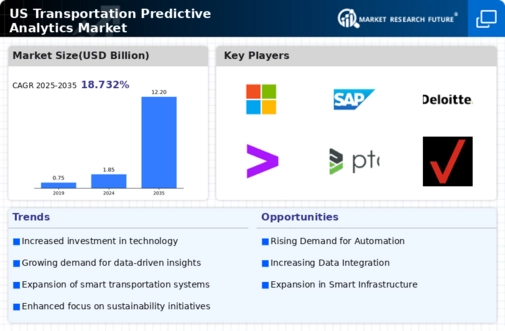The US Transportation Predictive Analytics Market is witnessing accelerated growth due to the increasing demand for data-driven solutions that enhance operational efficiency and improve decision-making in logistics and transportation. As various players compete for market share, understanding the competitive landscape is essential for stakeholders to gauge their strategic positioning. Advancements in technologies such as machine learning, artificial intelligence, and big data analytics have made predictive analytics a vital tool for transportation companies aiming to optimize their operations.
Key factors driving competition include technological innovation, user-friendly interfaces, and comprehensive service offerings that cater to the unique needs of the transportation sector. The growing focus on safety, cost reduction, and customer satisfaction further intensifies the competition, prompting companies to develop more robust and integrated analytics solutions to maintain their edge in the market.Microsoft has established a solid foothold in the US Transportation Predictive Analytics Market through its advanced cloud computing capabilities and extensive artificial intelligence tools.
The company's strengths lie in Azure's cloud infrastructure, which allows transportation companies to harness vast amounts of data as well as utilize predictive analytics for operational insights.
Microsoft's investment in solutions tailored to the logistics industry offers transport firms predictive maintenance, route optimization, and demand forecasting, enhancing their operational efficiency. Furthermore, the company has built strategic partnerships and integrations with other platform providers, enabling seamless interoperability and providing a competitive advantage by enhancing the overall customer experience. The robust analytics capabilities of Microsoft facilitate real-time data processing and adoption of predictive models, helping organizations address evolving market challenges effectively.
SAP, on the other hand, is a significant player in the US Transportation Predictive Analytics Market, known for its comprehensive enterprise resource planning and cloud-based solutions. SAP's strengths include its powerful analytics tools like SAP Analytics Cloud, which allow organizations to derive actionable insights from transportation data easily. Its product suite is specifically designed for supply chain and logistics management, focusing on predictive analytics for inventory management, fleet tracking, and operational forecasting. The company has successfully executed several strategic mergers and acquisitions to bolster its analytics capabilities, further enhancing its market presence.
By integrating advanced analytics into its existing solutions, SAP provides its clients with a holistic view of their transportation operations. This integration empowers firms to leverage historical and real-time data, streamline their processes, and make informed decisions. In the competitive landscape of transportation predictive analytics in the US, SAP continues to position itself as a leader by continuously evolving its product offerings and addressing the specific needs of the industry.






















